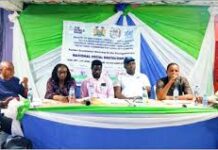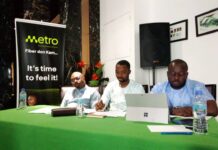The High Commissioner of the Republic of Ghana to Sierra Leone, Francis Abakah, has called at State House to bid farewell to His Excellency President Dr Julius Maada Bio, after four years of his tour of duty in the country.
He said it was a pleasure to serve his country in Sierra Leone, and thanked the government of President Bio for his consistent assistance in promoting peace and security in the sub-region.
High Commissioner Abakah further noted that during his stay in Sierra Leone, he saw enormous transformation, ranging from the introduction of the Free Quality School Education Programme, to major reforms in the legal system and the just concluded launch of the socioeconomic development programme for persons with disabilities. He added that those transformations were good for nation building.
“Thank you very much, Your Excellency, for making time to see me and my delegation. Ghana and Sierra Leone have enjoyed great diplomatic relations. We shall always continue to support each other,” he maintained.
In a brief remark, His Excellency President Dr Julius Maada Bio thanked the outgoing Ghanaian High Commissioner, saying that the two countries had enjoyed sisterly relations in the region for a long time. He noted that “there was always a time to say hi and time to say goodbye”.
“I want to wish you well in your new posting. I am happy that we have been able to live together. Thank you very much,” he concluded.
Bar Association Awards Over 20 Eminent Legal Practitioners
Bar Association President receiving her own award from the Chief Justice
The Sierra Leone Bar Association on Friday, 10th December 2021 at the Country Lodge Hotel in Freetown during their Annual Dinner and first Awards Night awarded over 20 eminent Sierra Leonean legal practitioners for their dedicated service and outstanding reforms in the administration of justice.
President Bio, First Lady, Chief Justice and Wife on the High Table
The Guest of Honour was His Excellency President Dr Julius Maada Bio who presented an Honorary Award to the Country’s Chief Justice, His Lordship Justice Desmond Babatunde Edwards in recognition of his innovative reforms in the Judiciary.
The Bar Association President, Madam Michaela Eddinia Swallow used the occasion to call on President Bio to ensuring the immediate review of the Sierra Leone 1991 Constitution.
“Let me also use this opportunity to state that the Sierra Leone Bar Association is concerned about the Constitutional Review Process and we hope that as a Reformer you will usher us a progressive Constitution,” said President Swallow.
She saluted President Bio’s bravery and courage in abolishing the Death Penalty. The Bar Association President went on to commend President Bio for the giant developmental strides undertaken so far.
“Mr. President, your legislative reform agenda which has manifested in the repeal of the seditious libel law, the proposed Gender Empowerment Bill and your support for a proposed Constitutional amendment to allow dual citizens to be qualified to be elected as Members of Parliament will serve as an inspiration for many of your colleagues in the sub-region,” she said.
Whilst commending the Chief Justice for what she described as “impressive reforms in the Judiciary,” President Swallow reminded the Chief Justice about the challenges lawyers are confronted with in Courts. She highlighted delayed judgments, long adjournment of cases and the absence of prescribed fees for execution of judgments.
“I am sure many judges here had once been practitioners and they are all too familiar with these challenges,” Ms Swallow said.
She however assured the Chief Justice of their unwavering support to help address these challenges.
She finally encourages colleague lawyers to be united as, “where there is unity there is strength.
This year’s Bar Association Dinner was climaxed with awards ceremony and the recipients included the Justices of the superior court of judicature, senior practitioners, pupils, staff members in the Judiciary and the Justice sector.
Marampa Mines Landowners Demand Removal of Community Relations Department
By Hassan Bruz
Lunsar Town in the Marampa Chiefdom will once again occupy the centre stage for the wrong reasons, if swift moves are not taken by the relevant authorities to unruffled the situation. This time around, the potential rumpus is bound to be far more destructive considering the categories of Persons involved.
The pending uprising will certainly affect the apparent smooth operations of the Marampa Mines in case the issue is not treated with the deserved seriousness. For those following the trend in the Marampa Chiefdom Headquarter Town of Lunsar, it is heart thudding to recall how the incident that led to the destruction of the Compound of Paramount Chief Bai Koblo Queen II and the subsequent attack on the Lunsar Police Station started in triviality. Little did People know it was going to result to such a huge damage of properties including some youthful’ lives.
That incident had a spreading repercussion as some people were instantly relieved from their gainful employments whose Dependants are now struggling to eke a living.
Although that incident occurred a little over one year now and the Paramount Chief is almost back in Lunsar, yet the matter has not been thoroughly resolved as many more people are currently languishing at the Maximum Correctional Centre in Freetown. All of these zeroed to the fact that a ‘stitch in time saves seven’ which means the Incident could have been averted if swift measures were adopted in time.
It is proper to state that a similar situation is developing and in the same Chiefdom Headquarter Town of Lunsar. Several consultative meetings have been conducted and decisions have already been made. So far People seemed very much resolved to go the extra mile should their concerns continue to be disregarded. Unlike the previous incident in which the demands of the Rioters were not quite known, this time around there seem to be a classified set of People with a defined demand. This is about the Owners of the Lands on which the Marampa Mines – the Company that is Mining Iron Ore in the Chiefdom operates. They comprised a total of 19 Villages of which 9 Villages are situated along the Concession Area. In a bid to be able to speak with one voice and make themselves much more relevant, they were able to establish what is now being referred to as – ‘The Marampa Landowners Association’.
The mining company in a corresponding manner also established what is called the – Community Relations Department whose core mandate is to enhance a cordial relationship between the Mining Company and the Landowners. As an intermediary body, it is required to protect and promote the interest of the Landowners. Besides the coordination of the payment of Surface Rent to Landowners, the Community Relations Department is also expected to influence the Recruitment of Locals for gainful employment into the Mining Company and other fringe benefits. One of the critical concerns for Landowners is the aspect of joblessness. This is seemingly being provoked by the fading number of their Farmlands as most of it has been swallowed by the activities of the Mining Company. Another key concern is the Road Network to their respective Localities and the conspicuous absence of Recreational Centres in their Communities. The once tarred Roads and Streets in the sweet old days of the DELCO the Company that commenced Mining Operations have since been abandoned to rot down. Currently the Inhabitants can only boast of Bush – Paths. Those who have cause to travel to Lunsar Town for any business whatsoever, are left with the only alternative of risking their live along the Mines’ Maine Route where the heavy duty vehicles that transport the Ore ply in high speed.
AIG ADMONISHES BIKE RIDERS IN BO CITY
By Anthony Vandy
As part of his work plan, the Regional Police Commander South AIG Aiah Edward Samadia in collaboration with the Brigade Commander of the 5th Infantry Brigade South, Brigadier General AB Conteh and other stakeholders have on Thursday 9th December 2021, engaged a cross section of the general membership of the Commercial motor bike riders at the Coronation field in Bo City.
AIG further maintained that he had been yearning to engage bike riders owning to what he had observed since he took over the leadership of Policing administration in the Region.
He addressed them based on the following thematics:
Indiscipline and lawlessness among Commercial motor bike riders ranging from riding unlicensed and unregistered motor bikes, overloading etc
Drug related issues and violent behaviour among youths.
Night offences, lots of drug dealers, hardcore and common criminals were arrested and prosecuted in a bid to make the society a crime free Community, AIG added.
He furthered that he had contributed immensely towards the progress of the Bike Riders Union when he was the Regional Police Commander Freetown East, AIG maintained.
Brigadier General AB Conteh reiterated that bike riding is one of the fastest growing population (self-employment) in Sierra Leone and its incumbent on them to complement the efforts of the security sector in the fight against crime in their respective Communities.
He encouraged them to be patriotic and support national development rather than riding unlicensed and unregistered motor bike, meaning that they are not a patriot but a lawless person, he concluded.
Similar sentiments were expressed by both the LUCs of Bo West and East Divisions and OSD Coordinator South in order to lure the commercial motor bike riders to deviate from such barbaric act.
Quick re-action of bike riders by taking the law into their own hands rather than following the due process of the law has become a serious security menace among Commercial motor bike riders, ACP Joseph W. Saffa concluded.
The CSO representative, Mr. Mustapha Kpaka Junior thanked the security sector, especially the AIG for such a wonderful platform.
He described the gathering as first of its kind in the history of policing administration in this part of the country.
He further maintained that “if we don’t pursuit lawlessness in society then lawlessness will pursue us in society” he ended.
Comments and questions were asked in a form of planning to curb lawlessness in society which were answered responsibly by the Regional Police Commander South AIG Aiah Edward Samadia.
However, the Police boss South urged them to comply with all the problems highlighted in conformity with the law otherwise he had no alternative but to execute his duty in accordance with the law.
The meeting ended in a peaceful atmosphere as they were pleased with the initiative of the police boss
Public Review Article
THE SECRET AND GAME PLAN OF THE MIDTERM CENSUS By
Sylvanus Fornah Koroma Jr. (What A Man!)
The deceitful Statistician General of Statistics-Sierra Leone (SSL or Stats-SL) has the propensity to bring unrest in Sierra Leone if the government does not guide against this man’s falsity. Just a few days ago, someone in Kenema issued threats of violence on social media that has gone viral. The message was a threat of violence against Northerners residing in Kenema that stand with and are in support of the All People’s Congress (APC) position of non-participation of its members and supporters in the controversial and unprecedented midterm electronic census. But on a special piece, those issues of threats and acts of violence would be addressed. For now, the focus is on the deceitful Statistician General Professor Mallam O Sankoh (the boy from Warima as he often describes himself). This professor only cares about himself and things attached to his name. He is proud to say he changed Statistics Sierra Leone (SSL) to Stats-SL, District Census Officer to District Census Coordinator, removed Field Officers from the structure of supervising the census and condensed the four levels of census training to two. But these are legalities that we will save for an appropriate time. Meanwhile let us focus on the analysis of the table above, labeled as Table 1 which exposes the reasons for the mad rush for an unprecedented mid-term census that has been condemned both locally and internationally including the European Union and The World Bank.
Table 1 is a comparative analysis of Enumeration Areas (EAs), Households and Estimated Population from 2021 Midterm Census Cartographic Mapping and the actual EAs, Household and Population of 2015 Census by district in Sierra Leone. In just six years, the population nearly doubles. This is not possible and therefore Stats-SL should explain how they arrived at this unprecedented growth. Take a glance at the difference in the number of EAs in 2015 and those in 2021. In the Eastern Region the number of EAs increased from 2797 in 2015 to 6053 in 2021. Making and addition of 3256 which is 116.4% increase in 6 years. It must be noted that Kono only has 586 of the 3256 EAs. In other words, Kenema and Kailahun have increased their EAs by 2670.
Whereas the Northern Region has increased its EAs from 2519 in 2015 to 3889 in 2021 which is 54.4% increase in 6 years. In other words, 1370 EAs have been added to this region since 2015. This means that Kenema alone which has 1721 EAs has 351 more EAs than the whole of the Northern Province (i.e., Bombali, Falaba, Koinadugu and Tonkolili).
Whereas the North-Western Region has increased its EAs from 2011 in 2015 to 3156 which is 56.9% increase in 6 years. The number of additional EAs in this region is 1145. Again, the number of increased EAs in Kenema district alone surpasses the whole of the North-Western Region by 576 EAs.
Whereas the number of EAs in the Southern Region has increased from 2690 in 2015 to 5530 in 2021 which is 105.6% increase in 6 years. This means that the EAs have increased by 2840. In other words, the number of increased EAs in just the Southern Region is 325 more than both the regions of North and North-West combined. In Pujehun district alone, they have 944 EAs whereas the whole of North-West Region has 1145 EAs which is a difference of 201 EAs between the districts and the whole region.
Whereas the Western Area has increased its EAs from 2839 in 2015 to 5106 in 2021 which is 79.9% increase in 6 years. The number of additional EAs is 2267. Bo district has more additional EAs than Western Urban and Kenema has more additional EAs than Western Rural. In a nutshell, the South and Eastern Regions have 1314 more additional EAs than the North, North-Western Region and the Western Area combined.
The Household is generally defined for the purposes of census to mean ‘all the people who occupy single housing unit regardless of their relationship to one another. Family households have a householder and one or more additional people who are related to the householder by marriage, birth, adoption or employment. A Housing Census is the official enumeration of all living quarters (occupied and vacant) in a country at a specified time.
Whereas the Eastern Region number of household mappings increased from 295,035 households in 2015 to 561,952 households in 2021, there is a total increase of 266,917 households which is 90.5% increase in 6 years.
Whereas the Northern Region number of household mapping increased from 234,072 in 2015 to 379,558 in 2021. There is a total increase of 145,486 households which is 62.2% increase in 6 years. This means that the whole of Northern Region only has 9003 more households than Kenema as a district. Again, the Eastern Region has 121,431 more households than the Northern Region.
Whereas the North-Western Region number of households mapping increased from 212,960 in 2015 to 300,258 in 2021. There is a total increase of 87,928 households which is 41.0% increase in 6 years. This means that the Eastern Region alone has 34,133 more households than the North and North-Western Region combined. In fact, even Kailahun alone has 1599 more households than the whole of the North-Western Region.
Whereas the Southern Region household mapping increased from 271,016 households in 2015 to 511,097 households in 2021. There is a total increase of 240,081households which is 86.6% increase in 6 years. Again, the number of increased household mappings of the Southern Region surpasses both the Northern and North-Western Regions combined by 7297 household. In fact, the difference of households in Pujehun (85328), the whole of North-Western Region (87298) is 1970 households.
Whereas the Western Area number of household mapping increased from 334,148 households in 2015 to 496,146 households in 2021. There is a total increase of 161,998 households which is 48.5% increase in 6 years. Kenema only has 25,515 households less than the whole of Western Area. In a nutshell, the South and Eastern Regions have 112,216 more households than the North, North- Western Regions and Western Area combined.
A population census is the official enumeration of all persons in a country at a specified time. An estimated population is developed from the pilot census and the cartographic mapping done. We will hereby do an analysis of the Actual Population in 2015 Census and the Estimate Population from the 2021 mapping.
Whereas the Eastern Region actual population was 1,642,370 persons in the 2015 Census, it is now estimated at 3,371,712 persons in 2021. There is a total increase of 1,729,342 persons which is 105.3% increase in 6 years.
Whereas, the Northern Region actual population was 1,346,316 persons in the 2015 Census, it is now estimated at 2,227,348 persons in 2021. There is a total increase of 931,032 persons which is 69.2% increase in 6 years. The estimated increased population of Kenema district alone has a much- expected added population in 2021 as the whole of the Northern Region with just 16,791 persons difference.
Whereas the North-Western Region actual population was 1,161,885 persons in 2015 census, it is now estimated at 1,801,548 persons in 2021. There is total increase of 639,663 persons which is 55.1% increase in 6 years. This means that the Eastern Region is estimated to have 105,647 more persons than the combined regions of the North and Northwest.
Whereas the Southern Region actual population in the 2015 Census was 1,441,308 persons, it is now estimated in 2021 at 3,066,582 persons. There is a total increase of 1,625,274 persons which is 112.8% increase in 6 years. Again, the sum total of the estimated added figure in the Southern Region surpasses the joint number of persons in both the combined regions of the North and North- West by 1,570,695.
Whereas the Western Area actual population in the 2015 census was 1,500,234 persons, it is now estimated in 2021 at 2,976,876 persons. There is a total increase of 1,476,642 person. Which is 98.4% increase in 6 years. In a nutshell, the South and Eastern Regions have 307,279 more estimated added persons than the people in the North, Nort-Western Region and Western Area combined.
Stats-SL has recently commented about its published results of the unpopular Midterm Pilot Census and Cartographic Mapping result on its website; when at about the same time the World Bank had written its famous Midterm Census letter addressed to both Mr Dennis K. Vandi, the Minister of Finance and Dr. Francis Kaikai, the Minister of Economic and Development Planning, the Chief Minister, the Statistician General and the Executive Director, The World Bank were copied.
The World Bank did not only pull out of the process, but they also withdrew their financial support. The acclaimed published pilot census was not evaluated before the said date for the start of enumeration on December 9, 2021. There is evidently no field operation plan and the training was haphazardly done. We are now into the second week of the controversial, problematic and unprecedented midterm census and many enumerators do not know where to work and who supervised them. Professor Mallam O Sankoh does not seem to be in charge as Chief Census Officer.
This so-called Midterm Electronic Census is a flawed process; training was collapsed from four to two levels bypassing the regional and chiefdom level training, quality control mechanism is not there as field officers were not recruited to supervise data collection at chiefdom level. Because there is no deployment plan, enumerators are not familiar with their places of work, cannot identify Enumeration Area (EA) boundaries and most of them cannot speak the language of the localities they are working in. Another challenge is that most of the enumerators cannot operate their tablets and the data collected will be lost if not saved. Worst of all, since there is a gap (due to the absence of Field Officers) enumerators deployed in the rural areas might not go there and will ‘capstone’ the data (data from the top of their heads). The truth is that the boy from Warima i.e., the Chief Census Officer is not mindful about these lapses.
The issues raised by the World Bank are legitimate and should have been addressed before the start of enumeration. International Best Practice is that any issue raised by any partner, especially technical issues, should not be overlooked by the Chief Census Officer and his team. Samuel Ansumana, the Director of Communication Stats-SL reiterated the importance of expert and the technical partners on his interview on November 30, 2021, on Radio 98.1 FM, Good Morning Salone program. But yet in practice, Stats-SL is ignoring its own acclaimed belief. Going on with the census count without addressing the legitimate concerns raised by the international partners and experts is a breach of International Best Practice. This another major anomaly of the midterm electronic census!!!
The Chief Census Officer, Statistician General, Professor Mallam O Sankoh said he is the rapporteur of the UN Statistics Division. So, one would expect he followed the compendium of principles prescribed by the United Nations in conducting the census. This compendium was put together by ‘Friends of Chair’ (i.e., a technical group in the UN Statistics Division) and discussed and ratified by all member states of the UN.
Why is the professed UN rapporteur, the Statistician General, professor Mallam O Sankoh bringing in the processes that are not aligned with the principles and recommendations in conducting rounds of censuses. Well, he is the boy from Warima, a professor and maybe he is above the UN principle. The professor should know that no one stops him from innovating, but this should not be against agreed principles and law.
N.B.
Professor Mallam O Sankoh recruited 15,000 enumerators but the actual Enumeration Areas (EAs) as per the mappings are 23,734. This being the case, there are 8,734 more enumerators or otherwise some enumerators have to serve more than one Enumeration Area to cover all 23,734 EAs.
The huge discrepancy signals some amount of inefficiency and these are believed to be part of the the concerns raised by the World Bank. The lack of justification for such a huge number of EAs not been accounted for, leaves many curious minds questioning the process and thus increase the justified level of doubt on the entire process.
We need to understand or get explanation from the Statistician General and Statistics-SL to answer these questions:
1)What economic activities have taken place to cause this economic change as stated by the Pilot Census and the Cartographic Mapping within just 6 years?
2)Most of the districts in the South and East Regions grew over 100 % in all the said assessment but none of the districts in the North and North-Western Regions went even as close as 90%. The question is why is this so?
3) For obvious reasons, would anyone want to ask questions about the Western Area figures? FOOD FOR THOUGHT!!!
2020 AUDIT REPORT IS OUT, OVER TO YOU ACC-AND PARLIAMENT
By Brima Sesay
Parliament has this week tabled in Parliament the Auditor General’s Report for the Financial Year ended December 2020 produced by the Audit Service Sierra Leone. Already, copies of the report are in the public domain. It is during this time of the year that the Audit Service Sierra Leone releases the annual Audit Report of the previous year.
Section 119 of the 1991 Constitution of Sierra Leone empowers the Auditor General to audit the public accounts of Sierra Leone and all public offices. This is something the Audit Service has been doing quite well over the years. Like previous Audit Reports, the 2020 report looks damning. The report records a total loss of Le 153,916,933,928.25 spanning from 2016 to 2020. But in 2020 alone, the report says a total of Le 113,133,032,085.02 was lost. As alarming as these figures tend to be, I will not describe the report as “sensational”, as the Minister of Information was quoted as saying, or “just a mere opinion” as a former Commissioner of the Anti-Corruption Commission (ACC) once put it.
For now, one of the best things to do is to look up to the institutions at the forefront of ensuring transparency and accountability in governance- that is the ACC and Parliament. I think it is not too much again about those damning figures, but all about the actions that will be taken by the public institutions responsible for public accountability.
I am heartened by the Press Release of 14th December 2021, issued by the ACC in which it informs the public about the fact that the tabling of the 2020 Audit Report had been brought to its attention. The release goes further to state: “The ACC attaches utmost importance to the Auditor General’s Reports. As such, in recent times, the Commission had provided, and will hopefully continue to provide, updates to the public through its Serialized Media Releases on the many interventions and outcomes regarding the Audit Reports 2015-2019 which resulted in investigations, prosecutions, convictions, recovery of huge sums, prevention measures, and, in appropriate situations, exoneration and clearing of persons and institutions. More importantly, the Commission is also cognizant of the Constitutional role of Parliament regarding this issue and it shall be collaborating with them.”
What I have also come to love is the promptness of the response from the leading anti-graft agency. It is good that they have immediately started looking at the contents of the report, as the press release further states that: “The ACC will work with Parliament and Audit Service Sierra Leone to ensure that each party performs its role to ensure that the various issues of concern are speedily and accordingly addressed without favour for anyone. The ACC is now examining the reports to ascertain violations of the Anti-Corruption Act 2008 as Amended in 2019, or needs for intervention by the ACC; and/or identify system weaknesses within the audited institutions for appropriate prevention measures or recommendations to address them”.
In the recent past, I have come to put so much trust in the leadership of the ACC for being very attentive to the contents of audit reports, either specialized or the usual annual audit reports. We have seen how the Commission was able to make huge recoveries –which now stand at over 31 billion leones- due to its interventions in these reports. In some cases, material resources are recovered- like was the case of the 47 laptops and generator in the NaCOVERC case. There are other instances of investigations leading to prosecution. Systems and processes reviews have also been undertaken by the ACC’s Corruption Prevention Department to strengthen accountability systems in public offices. We have also known of cases where punitive administrative actions were taken against public officials that led to their dismissal, suspension or demotion. I know by this time, all those officials or leaderships of public institutions named in the just-released audit report will be experiencing sleepless nights. For me, this is the hallmark of accountability.
Parliament also has a role in this. I know there are instances when Parliament would refer certain matters to the ACC to further investigate where there are huge losses of public funds The Public Accounts Committee in Parliament has been very instrumental in all of this. At this time, we expect them to give ACC unhindered access to the report, as well as make referrals to the Commission for swift and concrete actions to be taken against public officials and institutions responsible for any public malfeasance. I am happy that the two institutions –ACC and Parliament- have been collaborating very well. It is also good that the Audit Service also provides a helping hand in some of these interventions.
Again another Audit Report is out, again we await strong concrete actions from the ACC with support from Parliament and where necessary Audit Service to hold accountable those responsible for any malfeasance.





































